#vegetable nabe
Photo
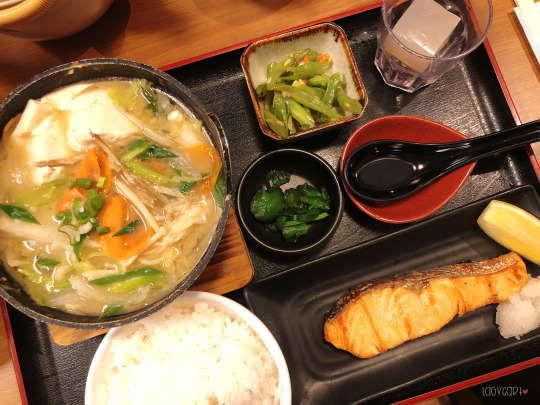
ume tei 梅亭, mytown shopping center.
came here for food with family as we wanted to visit ikea which is next door, and this place has good reviews. their menu has lots of different set meals to choose from, which is suitable for families and groups to suit different preferences.
i picked the vegetable nabe with grilled salmon set, it comes with white rice, pickles and a small bowl of french beans and jelly as well. the soup has really strong ginger taste, if you love ginger, you will enjoy this soup very much, for me it was alright since i’m not a fan of ginger. the salmon is good, not too cooked or dry, just perfect moisture and the lemon and radish is a good compliment.
overall service here is good, their staff are quite responsive even though the restaurant is full, did not wait too long for all our food to arrive as well. other set meals ordered by my family was also nice and we enjoyed it. the pricing is also rather reasonable which is a huge plus point. and the best part about this place is that it’s inside a bookstore, the interior and surroundings are just so nice.
#food#japanese#ume tei#梅亭#mytown shopping center#cheras#ikea#bookstore#set meal#variety#reasonable price#good service#popular#comfortable#good portion#vegetable nabe#grilled salmon#ginger#comforting#good experience#recommended#ambiance#interior
1 note
·
View note
Text
Masterlist of Gun Park + Goo Kim ✨Bullshit✨
Guess who hit the link limit again
Lookism Masterlist | Part 2 ☞ (multi-character headcanons/dynamics) more Gun + Goo here
Lookism Storylines ☞ (fun shit. mix of x reader and with reader)
You're here! Gun + Goo | Part 2 | Jake + Samuel | Vin + Ryuhei | Everyone Else ☞ (single character-centric standalones)
... Even More Lookism Masterlist ☞ (different characters in same scenarios series) more Gun + Goo here
How To Fight/Viral Hit Masterlist | Seong Taehoon
Character-Centric Standalones

Gun Park x Reader: Fairground/Haunted House Shenanigans
Gun Park x Reader: Fighting Dirty
Gun Park x Reader: Retirement
Gun Park x Reader: Soft
Gun Park x Reader: Holding his attention
Gun Park x Reader: Enough
Gun Park x Reader: Waiting
Gun Park x Reader: Red flag miscommunications
Gun Park x Reader: Eat your vegetables (feat Goo)
Gun Park x Reader: I do | After I do
Gun Park x Reader: Fried chicken
Gun Park x Reader: Just moved in
Gun Park x Reader: Marked
Gun Park x Reader: Funny
Gun Park x Reader: Masterpiece
Gun Park x Reader: Holding Hands
Gun Park finding a new successor - YOU
Gun Park x Kind!Reader: Opposites
Gun Park and his Emo Band
Gun Park x Reader: The Learning Genius | Good
Gun Park with Reader: The 'Learning' Genius. Except-
Gun Park x Reader: Early morning
Gun Park with Reader: Your biggest fan
Gun Park x Reader: Fifth Affiliates
Gun Park x Reader: Three kisses
Gun Park with Reader: Junkyard shenanigans
Gun Park x Reader: Crystal Choi
Gun Park with You, his successor
Gun Park x Idol!Reader: Questions
Gun Park x Sensitive!Reader: Making up
Gun Park x Reader: Physical Touch
Gun Park x Reader: For You
High School!Gun x Shy!Reader: Blush
Vampire Hunter!Gun Park x Vampire!Reader
Gun Park x Reader: Daydream
Gun Park x Reader: Sesame Seed
Gun Park x Reader: Arranged Marriage
Gun Park x Reader: Name
Gun Park x Reader: Home
Goo Kim x Reader: Mario kart
Goo Kim x Reader: Cosplay
Goo Kim x Reader: Fake Dating
Goo Kim x Reader: Reverse Isekai
Goo Kim x Reader: Money
Goo Kim x Reader: Cookies (feat Gun)
Goo Kim: Gen + romantic headcanons
Goo Kim x Reader: Checkmate
Goo Kim x Reader: Tired
Goo Kim x Reader: Silly questions at bedtime
Goo Kim x Reader: Kneecaps (feat Gun a lil)
Goo Kim x Reader: Brownies for your boyfriend
Goo Kim x Reader: Pinky promises
Goo Kim x Reader: Ring shopping (feat Gun)
Goo Kim x Reader: Partner 'privileges'
Goo Kim x Reader: Outfits
Goo Kim: Office Routines
Goo Kim x Reader: what's it worth?
Goo Kim x Reader: Comfortable silences
Goo Kim x Reader: Mystery guy
Goo Kim x Reader: Coffee Shop AU
Goo Kim with Reader: Summer afternoon
Goo Kim x Reader: Generous (feat. Gun Park)
Goo Kim x Reader: Dating (feat Gun)
Goo Kim with Reader: Injuries
Goo Kim x Reader: Hair
Goo Kim x Reader: Suspicious
Goo Kim x Reader: Making Space
Goo Kim x Reader: Cat
Goo Kim x Reader: Cycling through the love languages
Gun + Goo as YOUR older brothers hc
Gun Park + Goo Kim: Ice cream
How did Gun get his scar?
Gun + Goo: Time travel fuckery
Even more Gun + Goo shenanigans
Gun + Goo: Duo headcanons
Gun Park + Goo Kim: Theme song
Gun Park + Goo Kim: Sammy
Gun Park x Goo Kim: Equals
Gun Park x Goo Kim: Bruises
Gun Park x Goo Kim: Steal
Gun Park x Goo Kim: Nabe
Gun Park x Goo Kim: Whittling
Gun + Goo with Reader: Nobody talks like that | Gun Park x Reader: Somebody asked
Gun Park x Reader x Goo Kim: Soulless
Gun Park x Reader x Goo Kim relationship hc
Gun + Goo with Reader: Manga Raws
#lookism x reader#lookism#lookism fic#gun park x reader#goo kim x reader#gun park#goo kim#park jonggun#park jonggun x reader#kim joongoo x reader#kim joongoo#wannaeatramyeon
334 notes
·
View notes
Text
forty days and forty nights (day thirty-seven!) (part two!)
(you thought i forgot didn’t you)
“stay.”
"fine. now answer the goddamn question or starve." katsuki grunted, sifting through the bags. he glanced at the pot of water you had for the ramen and turned the heat up before taking out miso, chicken, and a variety of vegetables.
"I'm doing okay." you answer, studying his movements carefully. "what're you making?"
"chanko nabe." a classic comfort dish. he knew exactly what he was doing, the bastard.
"don't you have patrol today?" you ask, albeit somewhat reluctantly. part of you immediately regretted asking, because what if he had patrol right this minute and had to leave?
"no." katsuki said shortly.
"ah."
it was silent for a good few minutes. katsuki continued to work on prepping different ingredients— mushrooms, carrot, tofu— and you opted to sit and watch, since clearly he disapproved of your cooking.
"took off 'cuz i wanted to check on ya." katsuki mumbled finally.
“you took off for me?” you repeat, dumbfounded. katsuki clicked his tongue in annoyance.
“isn’t that what i just said?” katsuki snapped. “idiot.”
“thanks.” you smile. “can i help you cook?”
“no way in hell, instant ramen freak.” katsuki snorted. “sit your ass down, i’m cooking.” your face instantly snaps into an indignant state, highly offended at katsuki’s accusation.
“that’s not all i eat! it was just tonight!” you protest.
“you had so many goddamn ramen packets in your cabinet that you coulda fed my entire agency!” katsuki barked back. “i’m cookin’, that’s that.”
“fine.” you huff, sinking into one of the counter stools. “jerk.”
“dumbass.”
the chanko nabe was ready fairly quick, and, as an added bonus, made your newly-cleaned apartment smell heavenly. it was nice to be pampered.
“eat.” katsuki grunted, sliding a bowl to you across the countertop. he turned back around and began on the dishes.
“oh, katsuki, i’ll do the—“
“siddown.” katsuki interrupted, instantly glaring at you from over his shoulder. “no the fuck you’re not.
“ok.” you didn’t bother arguing because, again, he did make you food, and he did make your apartment smell good. you ate in silence as katsuki did dishes. it was amazing— salty and flavorful and delicious. it wasn’t until katsuki broke the silence that you bothered taking a breath from your food to breathe.
“you got a plan for after this?” he grumbled, almost reluctantly. you shrug.
“just… keep going with life, i guess.” you could tell your answer didn’t please katsuki, because he tensed, giving you quite a wonderful outline of his back muscles through his tight black t shirt (did he wear that everywhere?).
“the fuck you mean?” katsuki narrowed his eyes as he turned around, drying a knife off with a hand towel as he did so.
“well, what am i supposed to do?” you point out.
“go to therapy and that shit.”
“i don’t need therapy.”
“you haven’t addressed the damn thing once. bet my money you haven’t talked with pinky or shitty hair either.” katsuki set the knife down, focusing his attention on you, which, given the current subject, made you just a tiny bit uncomfortable.
“i didn’t need to,” you answer hesitantly. right? i’m fine.
“you gotta talk to someone.” katsuki rolled his eyes. “no one goes through that kinda shit and gets out unscathed.”
“oh.” you frown. “well, i’ll think about it, i guess.”
“tch. you better do more than just think about it.” katsuki scowled, before getting himself some chanko nabe and plopping down next to you. “you doin’ anything tomorrow?”
“working.” you reply. “just like usual. it feels weird not working today.”
“i meant after that, dumbass.” katsuki’s voice suddenly got a little quieter, a little less grumbly, but just a little more defensive. he stared at his chanko nabe.
“oh. i don’t think so.” you ponder. “why?” katsuki didn’t answer for a good few minutes.
“because—“ katsuki hesitated for just a nanosecond, trying to gather his words. “—because we’re going somewhere.”
“we are?” you blink, confused.
“if you fuckin’ want to, or whatever.” katsuki snapped.
“like…” you stop. do you dare presume? “like a date?”
“yeah.” katsuki glanced over at you, glaring. the tips of his ears were red, and his cheeks were dusted with pink. cute. “‘s a hike.”
“okay.” you said, smiling, probably responding quicker than necessary, but you didn’t care.
you had a date with katsuki.
“you gotta talk to someone. no one goes through that shit and gets out unscathed.”
(feel free to comment + leave ur thoughts :)
tags: @k0z3me @cherryblossomclarity @stevenknightmarc @failingstudents-blog @jazzafayesworld @faerikitty @deathsmajestysworld
#katsuki bakugo#bakugou katsuki#bakugo katsuki#boku no hero academia#my hero academia#bakugou#bnha#mha#bakugo x reader#katsuki bakugo oneshot#coffee shop au#pro hero bakugo x reader#pro hero bakugo
106 notes
·
View notes
Text
茨城県
Japanese Prefectures: Kantō - Ibaraki
都道府県 (とどうふけん) - Prefectures of Japan
Learning the kanji and a little bit about each of Japan’s 47 prefectures!
Kanji・漢字
茨 いばら、かや、くさぶき、シ、ジ briar, thorn
城 しろ、き、ジョウ castle
県 ケン prefecture
関東 かんとう Kanto, region consisting of Tokyo and surrounding prefectures
Prefectural Capital (県庁所在地) : Mito (水戸市)
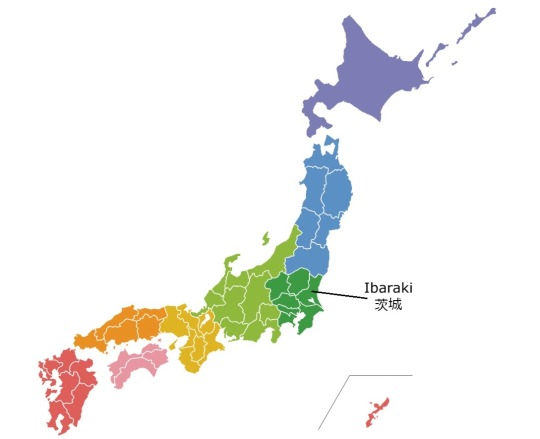
Amidst sprawling fields of beautiful flowers, Ibaraki also hosts Tsukuba Science City, Japan's premier research center and the home of Japan's space agency and numerous museums. Ibaraki is known historically for being the home of the Mito branch of the Tokugawa clan during the Edo Period and has long been associated with notable events in Japanese history. The first Nuclear Energy Research Institute was founded here in 1956. You can see space exhibits, actual space craft, and simulations at Tsukuba Space Center.
Outside of the major cities there are many natural areas to explore in the Suigo-Tsukuba Quasi-national Park. Hitachi Seaside Park is famous in the spring for its carpets of blooming blue nemophila. Kairaku-en is one of the Three Great Gardens of Japan. Mt. Tsukuba is a famous night view spot with a view of the Kanto Plain, including Tokyo Tower and the Tokyo Sky Tree, with a ropeway for convenient access. Ibaraki is also a major producer of natto.
Recommended Tourist Spot・おすすめ観光スポット
Fukuroda Falls (Fukuroda no Taki) - 袋田の滝
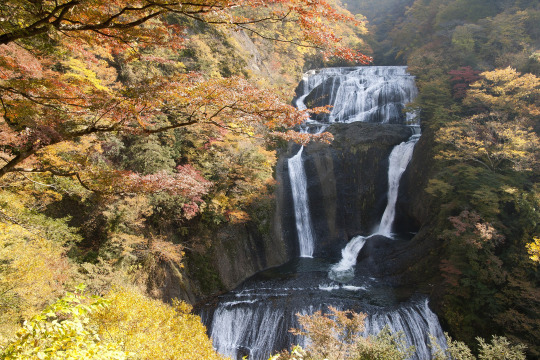
Photo by Own work, CC BY 3.0, Link
One of the three most beautiful waterfalls in Japan, Fukuroda Falls is a 120-meter tall cascading waterfall in northwestern Ibaraki Prefecture in the remote hills of the town of Daigo. It is also on the registered list of the Top 100 Waterfalls of Japan (determined by the Ministry of Environment). These falls are also called the Yodo Falls (Yodo no Taki) because the water stream falls on four large rock faces. It is also said that the renowned monk Saigyo Hoshi greatly praised the falls by saying that you should view the different beauty of the falls in all four (yo) seasons.
They are particularly attractive in early November with the peak autumn foliage as well as peak water flow. There are several different views of the waterfall, and you cannot view it in its entirety all at the same time. Within the Fukuroda Waterfall complex there are neon tunnels and elevators to take you to different levels and viewing platforms. It is said that you will be successful in love if you find a heart in the waterfall. There are also numerous hot springs nearby.
Regional Cuisine - 郷土料理
Monkfish Hot Pot - あんこう鍋

Photo by yosshi / CC BY-SA 2.0
The monkfish (also referred to as angler fish, goosefish, depending on the source I found) is a prized delicacy of Ibaraki and is best eaten fresh. Because these fish are too soft and slimy to cut up on a chopping board, they are prepared using the traditional tsurushi-giri technique, which involves cutting up the fish while suspended from a hook. In Japan, almost all parts of the monkfish are eaten, including fins, skin, gills, liver, stomach, ovaries and flesh—referred to as the “seven tools of the monkfish” in Japanese. The steamed liver is called ankimo and is considered a delicacy that may be eaten alone, or added to the hotpot soup for extra flavor. Anko nabe (monkfish hot pot) is a seasonal favorite consisting of monkfish, vegetables, and flavored broth.
Ibaraki Dialect・Ibaraki-ben・茨城弁
りんごあっけ? ringo akke?
Standard Japanese: りんごありますか? (ringo arimasu ka?)
English: Do you have any apples?
あしにあおなじみできちった ashi ni aonajimi dekichitta
Standard Japanese: 足に青あざができちゃった (ashi ni aoaza ga dekichatta)
English: I have a bruise on my leg
ごじゃっぺなやつだ (gojyappe na yatsu da)
Standard Japanese: いい加減な人; やくにっ立たない人
(iikagen na hito; yaku ni tatanai hito)
English: He's a good-for-nothing person
「行ってもいがっぺ?」 (itte mo igappe?)
「来たらいがっぺ」 (kitara igappe)
Standard Japanese: 「行ってもいいですか?」 「来てもいいですよ」
("itte mo ii desu ka?" "kite mo ii desu yo")
English: "Is it alright if I come?" "Yes please come"
あれは犬だっぺ (are wa inu dappe)
Standard Japanese: あれは犬です (are wa inu desu)
English: That is a dog
いがい車だな (igai kuruma da na)
Standard Japanese: 大きい車ですね (ookii kuruma desu ne)
English: That's a big car, isn't it
杖がおっちょれる (tsue ga occhoreru)
Standard Japanese: 杖が折れた (tsue ga oreta)
English: The cane broke in half
カラスををおっとばす (hato o ottobasu)
Standard Japanese: カラスを追い払う (hato o oiharau)
English: Drive away the crows
その日、大事? (sono hi, daiji?)
Standard Japanese: その日、大丈夫? (sono hi, daijyoubu?)
English: Is that day ok for you?
#japanese prefectures#日本語#japanese#japanese language#japanese langblr#langblr#studyblr#都道府県#茨城県#ibaraki
76 notes
·
View notes
Text
yukimura x reader
you find him cooking
0.7k words

You know how Yukimura is. He and tact never go along together. What can be expected of Yukimura is bare minimum in everyday life, lots of training and strong survival instincts. Yet when you found him in the kitchen it came across as a shock to you.
"You made this?"
"What, you don't believe me?" The evidence spoke for itself. Vegetable scraps, a knife on the countertop, some pots which he also cleaned after using and no one else in sight. It's clear as day he was the one who made it.
"No, it's just that... You and cooking isn't something I can imagine."
"Feel free not to have it then," he takes on a sulky tone at your hopelessness of him. He starts walking with a food tray in his hand, his dish sitting on top.
"No, wait. I want to have it." There's a hurry in your voice, afraid he may take his dish away because you're sceptical of his cooking. You start following him and end up at your shared room where he has set up the tray and is ready to have his meal. You settle down beside him taking a good look at him and then his creation.
It isn't gourmet-style cooking. Doesn't seem basic as well. Home cook level? Yeah, that's the way to put it.
You take the chopsticks and pick up the first bite slowly lifting it towards your mouth, your eyes analyzing the bite. Yukimura's gaze, too, is on you. Though you notice neither his stare nor the intensity with which he's staring.
He had made houtou nabe. Various vegetables sat along with flat noodles in a miso flavoured broth. If it were anyone else, they would've taken the effort to plate the vegetables in a more presentable or appetizing way, placed the spring onions in the centre, and the radishes, carrots and such in an array. It seemed as if he added the cooked vegetables blindly to the soup and noodles.
Enough with how it looks. A better job could've been done with the plating but it didn't look so bad. It looked as if someone had made it in a hurry, or without a care in Yuki's case, and that is fine.
With the first bite came the aroma of the stewed vegetables, the broth, and other condiments which he had used for flavouring. You take the first bite and immediately acknowledge how good it is. A hum escapes you along with a nod and Yuki knows that you love it.
"Not that bad, is it now?" He says with a smirk now but you know he was anxious about what would you say of his skills.
"How did you manage to cook something so good?" Not only are you surprised he made something you're more so surprised it tastes so good. It isn't as good as something Masamune would make but it is delicious.
"Don't talk as if it was a fluke I made something tasty." He heaved a sigh. "I know how to cook."
"You indeed do." You take another bite of his nabe smiling at how good it is.
"I've never seen you cook though. When did you learn to cook?" Your curiosity tumbles out of you.
"It was long back. It's a necessary skill to have during wars. You have to look out for yourself and all that." That's a typical Yukimura answer you're satisfied with it.
You almost spoke while the bite was still in your mouth. "And how did you decide on making something today?"
"Figured we could have something special once in a while."
Your face lights up at that. "Does that mean you'll cook often?"
"Look at you so impressed by my cooking. And here I thought you were sceptical of me being in the kitchen. Want me to cook for you from now on?" He has a smirk playing along on his lips. He is getting back to you for all your questions from before.
"I'm not impressed or anything." You suppress the blush on your face. The idea of him cooking for you has butterflies flying in your stomach.
He swiftly takes your chopsticks from you before diving in for a bite of his own. His actions catch you off guard. "Is that the reason why half of this bowl is empty?"
Damn him for noticing. You think he's gonna take the next bite for himself but he ends up feeding it you. That suppressed blush has furiously made its way back now. He sees his victory in that and offers his smile.
"No need to be shy. I won't mind cooking for you."

a/n: it was a spur of the moment kind of thing that i started writing this. i don't remember whether it was someone's route or a bonus story where yuki and mitsunari are cooking together and yuki gets in charge because mitsunari is clumsy. it was mentioned then that yuki can cook and personally i was surprised at that. i'm happy with how this turned out
#ikemen sengoku#ikesen#ikemen sengoku yukimura#ikesen yukimura#sanada yukimura#x reader#ikemen sengoku fanfic#ikesen fanfic#ikemen sengoku x reader#ikesen x reader
12 notes
·
View notes
Text
The Owl House Headcanon on Character's Favorite Japanese Dishes.
Luz Noceda: Okonomiyaki (Hiroshima-Style preferred). She likes it for it is a perfect comforting fusion between pancakes and takoyaki (which she had some bad memory from getting her tongue scrouged by it). Plus, she can choose a variety of fillings, which is great for her neurodivergent vibe (while also easily getting bored).
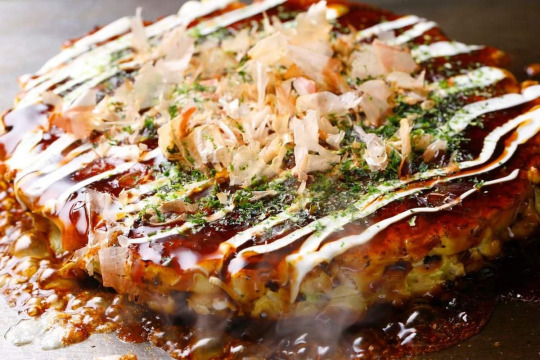
Amity Blight: Zaru Soba. She'd likely go for a dish that is simple yet defines Japanese elements. She would enjoy it with chunky chopped spring onion, wasabi-infused dipping, and hot tea on a side. After a few years of trying more Japanese dishes, she also got into shio udon and yakisoba. (and yakisoba-based okonomiyaki with her sweetheart)
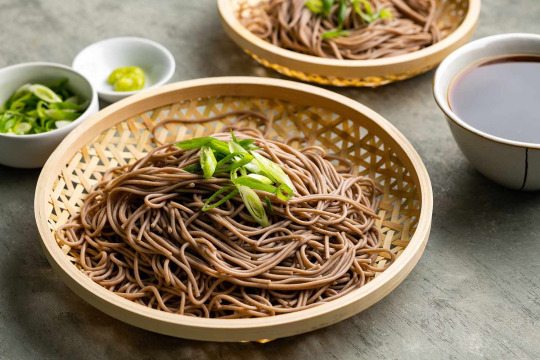
Willow Park: Kimchi Nabe; full of vegetables, proteins from meat, eggs, mushrooms, tofu, and gochujang-rich kimchi (Giving spiciness and Korean-ness that Willow never realized she needed). She loves her nabe with varieties and large quantities of proteins. Especially chicken-based meatballs (like in sumo wrestler Chanko Nabe), chicken breasts, lean slices of beef, and white tofu. Plus, extra spicy.
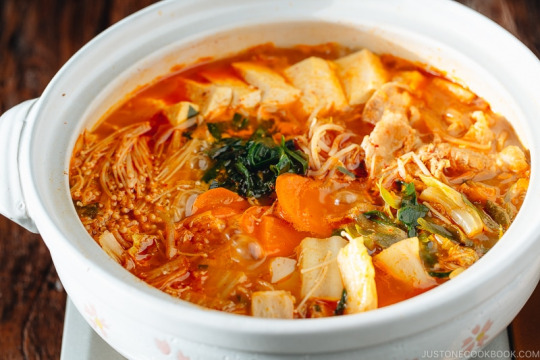
Gus Porter: Omurice with ketchup fried rice underneath a blanket of thin and creamy omelet. He prefers creamy demiglace sauce with mushroom and beef stock base, alongside ketchup and a dash of Kewpie mayo. Maybe steamed bacon with low-sodium, crabstick, or fish sausage for the side protein. Plus, he loves Sanrio and doesn't care about locals' eyes upon him enjoying his two plates of My Melody Omurice.(It's kids' size, so two is it).

Hunter Noceda/Park/Daemonne: Kushiyaki, especially those from old-school Yatai stalls. However, he would avoid poultry-based ones (especially the wings, as tributes to his lifesaver, Flapjack) and alcoholic drinks. He usually goes with beef and vegetables on the same stick. His favorite side drink is Ramune or Calpis yogurt drink. He usually has a few pods of salted edamame first, if offered.

Vee Noceda: Shojin Ryori meal from local Zen Buddhist temples. Somehow, she can tastes 'magic' in food, and enjoy talking about spiritual and morality topics with Buddhist monks(and nuns). She usually not paying them by money but doing them some cleaning and arranging the sutra. She sometimes enjoy draining magic from Omamori (Green one is a yum!).
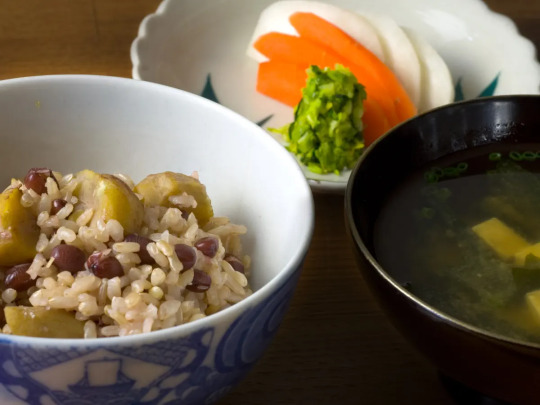
Edalyn Clawthrone: Tantanmen, extra broth, extra noodles, and a few extra pieces of boiled eggs. With rice on the side. After an extreme night (either work, or a party), she carves for carbs, proteins, and spices. Eventually, it becomes her usual comfort dish. Plus, it was worth her two meals and a pretty budget. If she feels extra fancy, maybe some extra meat as well.

Lilith Clawthrone: Kure's JMSDF (Japan Maritime Self-Defense Force)-style Curry Rice, with milk (low-fat, or soya milk) and salad with a light dressing. She prefers a vegetarian version and original taste that serves Japanese maritime forces. She eventually made her own thanks to befriending a friend who was a chef on a Japanese battleship in the Cold War.
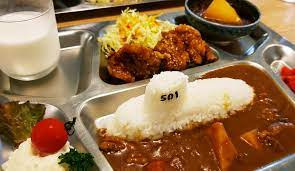
King Clawthrone: Set of different sushi varieties. He is into nigiri and maki with a few simple ingredients. He is into a grilled saltwater eel, salted boiled ebi (or tempura-fried), churnchy cucumber, and tamago. Onigiri is also his go-to, but he is not into raw meat.
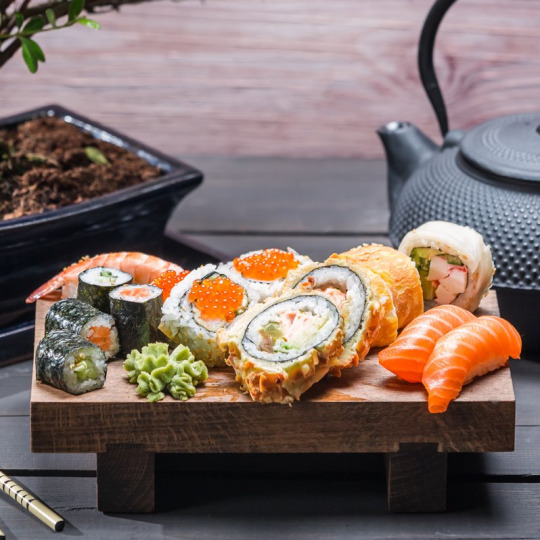
#the owl house#toh headcanon#luz noceda#amity blight#willow park#gus porter#toh hunter#vee toh#headcanon favorite food#japanese food#eda clawthorne#king clawthorne#king toh
29 notes
·
View notes
Text
BIBLIOGRAPHY - “ANIME FOODIES: LAID-BACK CAMP THE MOVIE”

This is the bibliography for our entry in the Anime Foodies series of panels, “Anime Foodies: Laid-Back Camp The Movie”. The sources include not only places from which we garnered background of the food we were cooking, but also sources that helped us determine how to craft our own version of the recipes we were creating.
This is the second Anime Foodies panel which has a formal bibliography of sources. Those marked with double asterisks are regular sources we’ve used in all of the panels in the series and are a good starting point for anyone interested in Japanese food and its history.
Bibliography:
Afro. Laid-Back Camp. Vol. 6, Yen Press, 2019.
Afro. Laid-Back Camp. Vol. 7, Yen Press, 2019.
“Anethum graveolens L.” Royal Botanic Gardens Kew, https://powo.science.kew.org/taxon/urn:lsid:ipni.org:names:837530-1.
Baker, Liren. “Taco Rice: Okinawa Taco Rice” Kitchen Confidante, https://kitchenconfidante.com/taco-rice-okinawa-taco-rice.
“Braised Yuba (Tofu Skins) with Vegetables” Sunberry Jam, https://sunberryjam.com/braised-yuba-with-vegetables/.
“Buttered Beere 1588” Oakden, https://oakden.co.uk/buttered-beere-1588/.
“Dutch Oven Roast Chicken” Self-Proclaimed Foodie, https://selfproclaimedfoodie.com/dutch-oven-roasted-chicken/#wprm-recipe-container-33149.
“Dutch Oven Roasted Chicken with Vegetables” Camping Adventures, https://adventures.camp/dutch-oven-roasted-chicken-with-vegetables/.
“Finnish Salmon Soup (Lohikeitto)” Skinny Spatula, https://skinnyspatula.com/salmon-soup-lohikeitto/.
Friesen, Katy June. “Where Did the Taco Come From?” Smithsonian Magazine, https://www.smithsonianmag.com/arts-culture/where-did-the-taco-come-from-81228162/.
Greg. “Hot Buttered Rum 2 Ways AND Fat Washing! | How to Drink.” YouTube, uploaded by How To Drink, 23 Nov. 2019, https://www.youtube.com/watch?v=cCbEwyntSCM.
“Hokkaido Salmon Hot Pot (Ishikari Nabe) 石狩鍋” Just One Cookbook, https://www.justonecookbook.com/salmon-hot-pot/.
“Hoto Noodle Soup from Yamanashi ほうとう” Just One Cookbook, https://www.justonecookbook.com/hoto-noodle-soup-yamanashi/#wprm-recipe-container-79243.
“Hōtō Noodle Soup (Hōtō Nabe)” RecipeTin Japan, https://japan.recipetineats.com/hoto-noodle-soup-hoto-nabe/.
“Houtou (ほうとう)” Food in Japan, https://www.foodinjapan.org/kanto/yamanashi/houtou/.
“How to make Houtou – Yamanashi local speciality noodle dish recipe” Japanese Cooking Class Tokyo, https://japanesecookingclasstokyo.wordpress.com/2014/01/03/how-to-make-houtou-yamanashi-local-speciality-noodle-dish-recipe/.
“How to Make the Best Tempura 天ぷら” Just One Cookbook, https://www.justonecookbook.com/tempura-recipe/.
Hua, Charlie. “Kiritanpo: Trying out one of Akita’s local specialties” Japan Travel, https://en.japantravel.com/akita/kiritanpo/55809.
“Hypomesus olidus” FishBase, https://fishbase.de/summary/Hypomesus-olidus.html.
“Hypomesus olidus” Integrated Taxonomic Information System – Report, https://www.itis.gov/servlet/SingleRpt/SingleRpt?search_topic=TSN&search_value=162031#null.
**Ishige, Naomichi. The History and Culture of Japanese Food. London, Kegan Paul Limited, 2001.**
“"Ishikari" Salmon Hot Pot (Ishikari nabe)” NHK World – Japan, https://web.archive.org/web/20201101192650/https://www.nhk.or.jp/dwc/food/recipe/kyou_12310.html.
“Ishikari Nabe Recipe (Salmon and Miso Hot Pot in Hokkaido)” Cooking With Dog, https://cookingwithdog.com/recipe/ishikari-nabe/.
“Japan-Mexico Relations (Basic Data)” Ministry of Foreign Affairs of Japan, https://www.mofa.go.jp/region/latin/mexico/data.html.
“Kiritampo Nabe (Rice Stick Hot Pot)” NHK World, https://web.archive.org/web/20180318093216/http://www.nhk.or.jp:80/dwc/recipes/detail/138.html.
“Kiritanpo (きりたんぽ)” Food in Japan, https://www.foodinjapan.org/tohoku/akita/kiritanpo/.
Laid-Back Camp. Directed by Yoshiaki Kyougoku. C-Station, 2018.
Laid-Back Camp Season 2. Directed by Yoshiaki Kyougoku. C-Station, 2021.
Laid-Back Camp The Movie. Directed by Yoshiaki Kyougoku. C-Station, 2022.
Miller, Max. “Making 400 Year Old Buttered Beere.” YouTube, uploaded by Tasting History with Max Miller, 10 Mar. 2020, https://www.youtube.com/watch?v=ZlMhZvOX2ps.
“Motsunabe” Japanese food style, https://jpnfood.com/recipe/meat/motsunabe.
“Motsunabe: How to Eat and the Best Restaurants in Fukuoka” Savor Japan, https://savorjapan.com/contents/discover-oishii-japan/motsunabe-how-to-eat-and-the-best-restaurants-in-fukuoka/.
“Motsunabe recipe もつ鍋” The Japanese Food Lab, https://thejapanesefoodlab.com/motsunabe/.
“Motsunabe (もつ鍋)” Food in Japan, https://www.foodinjapan.org/kyushu/fukuoka/motsunabe/.
“Okinawa Taco Rice and Cheese (Cafe Style)” Sudachi Recipes, https://sudachirecipes.com/okinawa-taco-rice/.
“Okinawa Taco Rice (Video) タコライス” Just One Cookbook, https://www.justonecookbook.com/taco-rice/.
“Recipe of Speedy Lightly Flavored! Hakata-style Motsunabe (Offal Hot Pot) with Soy Sauce Based Soup” Ground-Skillet, https://ground-skillet.web.app/734-recipe-of-speedy-lightly-flavored-hakata-style-motsunabe-offal-hot-pot-with-soy-sauce-based-soup/.
“Salmon Hot Pot (Ishikari Nabe)” RecipeTin Japan, https://japan.recipetineats.com/salmon-hot-pot-ishikari-nabe/.
“Salmon Soup” Happy Foods Tube, https://www.happyfoodstube.com/salmon-soup/.
Sam. “Aburi Technique for Fish” Chef Epic, https://chefepic.com/aburi-technique-for-fish/.
“Seared Salmon Sushi (Aburi)” Cooking with Cocktail Rings, https://cookingwithcocktailrings.com/seared-salmon-sushi-aburi/.
**Singleton Hachisu, Nancy. Japanese Farm Food. Kansas City, Andrews McMeel Publishing, 2012.**
**Singleton Hachisu, Nancy. Preserving the Japanese Way. Kansas City, Andrews McMeel Publishing, 2015.**
“【Smelt Tempura】 How to make Smelt tempura With technical explanation to stand fins” YouTube, uploaded by 逢禅天ぷらチャンネル / AIZEN TEMPURA CHANNEL 1 Oct. 2020, https://www.youtube.com/watch?v=H3KTXNGGAL4.
“Soy Milk Hot Pot 豆乳鍋” Just One Cookbook, https://www.justonecookbook.com/soy-milk-hot-pot-tonyu-nabe/.
“Taco Rice (タコライス)” No Recipes, https://norecipes.com/okinawa-taco-rice/.
“Tentsuyu” Oishi Washoku Recipes, https://www.oishi-washoku-recipes.com/tentsuyu.
“‘Tentsuyu’ (Tempura Dipping Sauce)” Hiroko’s Recipes, https://www.hirokoliston.com/tentsuyu-tempura-dipping-sauce/.
Turkell, Michael Harlan. “Foil Yaki Is the Best” Taste, https://tastecooking.com/foil-yaki-best/.
U.S. Fish and Wildlife Service. Wakasagi (Hypomesus nipponensis): Ecological Risk Screening Summary. 8 Nov. 2019, https://www.fws.gov/sites/default/files/documents/Ecological-Risk-Screening-Summary-Wakasagi.pdf.
“What is the “King Tacos” which is loved by Okinawan?” Okinawa Labo, https://okinawa-labo.com/en/okinawa-taco-rice-1966.
**Wondrich, David. Imbibe! From Absinthe Cocktail to Whiskey Smash, A Salute in Stories and Drinks to “Professor” Jerry Thomas, Pioneer of the American Bar. Updated and Revised Edition. New York City, TarcherPerigee, 2015.**
“〆まで美味しい ごま豆乳鍋つゆ ストレート” Mizkan, https://www.mizkan.co.jp/product/group/?gid=07101.
“簡単タコライス” Lettuce Club, https://www.lettuceclub.net/recipe/dish/22978/.
“王道タコライス” Delish Kitchen, https://delishkitchen.tv/recipes/196315721972580774. “簡単!すぐ出来!タコライス レシピ・作り方” Kurashiru, https://www.kurashiru.com/recipes/80ca4e93-29d6-422a-8168-cf409ac46d23.
#nos anime#camping food#camping#food#laid back camp#yuru camp#anime#anime foodies#anime food#yurucamp#laid back camp the movie#anime bibliography#bibliography
31 notes
·
View notes
Text
I made tonyuu zōsui (Japanese soy milk rice soup.)

Zōsui is a nourishing Japanese rice soup cooked in dashi broth with vegetables and tofu. Ready in under 20 minutes, this tonyuu zōsui is hearty, satisfying, and the perfect comfort meal for the cooler season.
(I made it vegan + gluten free, because why not?)
Say hello to this cold weather essential soup that will warm you right up and keep you feeling well & cozy.
Zōsui, or Japanese rice soup is something my mom would make for me anytime I was sick or feeling unwell. I kid you not, my colds and fevers never last for more than a day or two after having copious amounts of this.
What is zōsui (雑炊)?
Zōsui (雑炊) is a rice soup made from pre-cooked rice and a soup base flavored with dashi and soy sauce. This dish is often made after hot pot (nabe) with the leftover soup. Made with easy to digest ingredients, it’s known as a healing or recovery soup which is ideal for when feeling sick or to cure hangovers.
What's the difference between zōsui and ojiya?
I think that ojiya (rice-based soup) is more well known outside of Japan. It’s known as the Japanese version of congee or jook where the rice is cooked in broth and almost resembles a thick soup. While both zosui and ojiya both have simmered rice in dashi broth, there are subtle differences between the two:
Zōsui (雑炊)
Dashi broth is flavored only with soy sauce.
Day old or frozen rice is rinsed first to remove excess starch.
Cooked for a short period of time to prevent the rice from losing its shape.
Ojiya (おじや)
Dashi broth is seasoned with soy sauce or miso paste. The flavor is much lighter and always uses water or a clear broth.
The rice is not rinsed, since we want that thick porridge-like consistency.
Cooked for a longer period of time purposely, so that the rice is softer and the grains of rice aren't visible.
Ingredients & variations
Zōsui is comprised of four components:
Dashi broth: You can use leftover hot pot broth, homemade dashi, dashi packets, or dashi granules. All these options are quick and easy to make. Be sure to sure to use kombu or shiitake dashi to keep it vegan. I used soy milk for a creamier zōsui, but you can also use water for a lighter broth.
Cooked rice: I like to use short grain Japanese rice, but medium grain can also be used. You can use frozen rice, rice cooked from the night before, or fresh rice.
Vegetables: Shiitake mushrooms and green onions are typically added for flavor. Plus, you can use any vegetables you have on hand.
Protein: Any protein of your choice! Typically ground meats like fish and egg are used. But to keep it vegan, use tofu or nattō. There are so many varieties of tofu so you can switch it up, too! Soft tofu, aburaage, smoked tofu, and etc. Here, I’m using yuba (dried bean curd), because it kinda mimics cooked eggs.
This rice soup is super customizable and a great way to use leftover vegetables at the end of the week!
This rice soup isn’t just tummy-warming and big on flavor, but it’s also packed with nutrition which is perfect for the colder season. It’s a great healthy meal for when you’re feeling under the weather, recovering from a cold or for when you just want something quick and easy yet still delicious and hearty. I hope you try and love this cozy-wondersoup as much as I do! ♡
Ingredients you'll need for tonyuu zōsui
2 1/2 cups unsweetened soy milk (625ml)
2 tsps. kombu dashi granules (8g)
2 1/2 tbsps. tamari sauce (38g)
1 cup cooked Japanese short grain rice (200g)
2 dried shiitake mushrooms, rehydrated (44g rehydrated)
2 sheets of yuba, rehydrated (30g rehydrated)
2 green onions, sliced
2 cups spinach (35g)
Instructions
Over medium heat, add the soy milk, kombu dashi, and tamari sauce to a small pot and stir to combine. Once the broth starts to boil, reduce the heat to simmer. Add the rice, mushrooms, yuba, green onions and spinach. Stir everything to combine.
Turn off the heat, cover the pot with the lid and let it rest for 5 minutes to let it thicken. Serve in a donabe (clay pot with a lid) and enjoy!
#tonyuu zōsui#Japanese food#food photography#my recipe#vegan and gluten-free recipe#recipes on Tumblr
3 notes
·
View notes
Text
THE FINAL SOUPFEST INGREDIENTS LIST
Each ingredient used will be highlighted a certain color. Ingredients highlighted green are considered excellent, ingredients highlighted orange are okay, and ingredients highlighted red are bad.
Purple is...a mystery. Is it good? Is it bad? Annalise doesn't even know.
These are based on Annalise's own preferences with ingredients!
Her rating will come after this post!
PSA: Any muse who has an allergy or intolerance to any of the ingredients listed will be able to have their own bowl of soup that Annalise magically conjured made with certain ingredients removed.
Vegetable broth (Annalise)
Batch of Potatoes (x2) (Christoph, Jake)
Potato (Ruby)
Giant whole tuna (Xiaolong)
A single cranberry (Nabe)
Bag of onions (Beacon)
Onion (Shamar)
Reindeer heart (Eerie)
Small but very spicy pepper (Kithri)
Elk meat (Elias)
Whole raw chicken (Ava)
Freshly caught peeled shrimp (Temperance)
Large turnip (Atreis)
Cubed, cooked and seasoned meat (Manos)
Small bowl of oregano (Giovanni)
Crushed garlic (Josep)
Ginger (Ruixiong)
Cumin oil (Rashid)
Smoked paprika (Mistral)
Flour (Amber)
Salt, from a tiny salt shaker (The Ore Horde)
Ponzu and minced spring onions (Teddy)
White mystery sauce (Malik) <- (don't worry, it's not what we thought it was)
Slightly old pumpkin, carved with a likeness of Smudge (Willy)
Large truffle (Versy)
Slightly stale mandrake (Maxwell)
Handful of sage and dried star anise (Zenyatta)
Miso soup stock (Chiasa)
Diced palm fruit (Iyana)
Roasted onions (Oísin)
Bottle of 14th-century spiced white wine (Rowan)
Beef stock (Kahann)
Pinky meat cubes (Davoth)
Extras (These are not ingredients for the soup, but rather food items that can be eaten alongside the soup! These will not be rated.):
Buns, for dipping in the soup (Robin)
Two loaves of brioche bread, gingerbread, piece of roast swan, plum puddings (Versy)
Berries, four drumsticks, pair of frog's legs, two tallbird eggs, leafy meat, two eggplants, snakeskin, batilisk wing, deerclops eyeball, monster meat (Maxwell)
Fried fish sticks with dipping sauces (Shamar)
7 notes
·
View notes
Text

My Blorbo's <3 Here's an excerpt from a future chapter about my fave underdogs!
Carne village was a surprising sight to behold.
‘Goblins and humans living together. What a world.’ Lukrut said as he laid under the shade of the tree. The group relaxed in the calm village, enjoying the fresh made bread and some pickled vegetables on top for dinner.
‘Its inspiring.’ Peter says as he watches the goblins train the humans. He had heard the worst of it from the villagers. They had been attacked by other humans, the Slane Theocracy and he gritted his teeth. How could they? How could they do something so barbaric?
It wasn't that surprising coming from the Slane Theocracy. Peter had lived at the border growing up, moving deeper into Re-estize as he’d grown to get away from the hypocrisy and cultish nature of the country.
Now he could see that maybe what the Slane Theocracy would have called sacrilege wasn't so bad? The goblins moved with the villagers, grouping off to talk and laugh, some played with the children as others worked on improving the town through new houses and the large wall they’d passed to get in here.
‘It's very peaceful.’ Dyne says, a hand to the ground. ‘This place is still healing but I can feel a peace in the soil.’ he says and the others nod along with him.
‘Makes you just want to settle down in a town like this… hey maybe Nabe?-’
‘No.’ Peter says, giving him a look over his shoulder sternly.
‘I know this is really nice.’ Ninye says, holding his staff to his chest ‘but what's the use of us in this situation?’ he asks with a tired look and Dyne chuckles.
‘There’ll always be a need for adventurers in some capacity.’ he says wisely and Peter nods.
‘A world where we don't have to fight non-human races? Sounds like more time to look for the swords of darkness to me.’ he says, gazing out over the village.
As Momon and Nabe rejoined their group it was sunset and the group was allowed to make a camp within the town, they were even given more food for bringing Nphirea and while the village didn't seem to have a lot, they shared what they had.
Peter clears his throat and the others look expectantly at him, looking up in excitement as he chuckles.
‘Alright alright. One song then bed.’ he says and the Swords of Darkness cheer and laugh.
‘A song?’ Momon asks and Peter blushes in his scratched cheeks.
‘I uhm. I'm a pretty good singer and so every night or so we sing and play music, just for entertainment.’ he says and Momon nods along, looking at Ninya who’s cast inventory and reaching inside.
‘Oh you have inventory?’ he asks and he smiles at him as he pulls out a guitar and hands it to Lukrut.
‘Only a small one. But it's better than nothing. I tend to keep this spell a secret, Mr Momon.’ he says with a conspiratorial smile.
He hands a fiddle to Peter and drums to Dyne and for himself a small kalimba that glows slightly.
‘Any requests?’ Peter asks, playing a long note on his fiddle to warm up and Momon shakes his head and relaxes back agAinzt a large rock.
‘None for me. I'm new to the area so dont know many of your songs.’ he says and the others smile and share looks.
‘Then we’ll have to educate you on songs of love and adventure.’ Lukrut sighs out, strumming a few notes to Nabe who winces and gives Momon a side eye, a plea for help maybe that he ignores.
‘Adventuring songs?’ he asks, interest piqued and Peter gives him a wink, playing a few notes and soon the group have started a matching melody.
‘Is the road I walk one of terrors or gold?’ Peter starts and his voice is baritone and smooth, cutting over the soft instrumentals and adding flair to his words as he sings softly along.
‘Shall I walk this path with you to hold, oh darling.’
The night carries on with music to soothe the soul, even Nphirea and Enri join their group to sing along with the folk songs or listen to Peter. The fire burns away, warming his plating and his bones beneath as Momon feels at ease. Enjoying the music.
6 notes
·
View notes
Text

SUMO player
This is a statue that symbolizes sumo in front of a chanko-nabe restaurant by a former sumo wrestler. Chanko-nabe is regular food for sumo wrestlers in the sumo stable. It is a large pot dish that boils vegetables based on meat and fish in a large pot at a time for a lot of sumo wrestlers who are tired from training. I love chicken chanko nabe.
#black and white#japon#monochrome#photographers on tumblr#photography#art photography#b&w#lensblr#original photographers#photograph#artists on tumblr#street#btw#photo#original#art#lensblr network#sumo
16 notes
·
View notes
Text

Well, that was amusingly random. This evening they finally delivered what is hopefully the rest of our Drakfrukt order.
Which included at least half a dozen of these, AFAICT instead of one of the flavors of self-heating hotpot bowls that Mr. C ordered. Weird substitution, but OK.
Thanks to Google Translate's camera support for helping me figure that much out, beyond "yeah, that looks like some type of packaged hotpot base, probably on the spicier side, and I am seeing some hiragana". 🤔 Those have no Western import labeling attached. That did lead me to what type it even is, and a hopefully more reliable translated ingredients list.
Definitely not what we ordered, but it doesn't look bad at all. And it miraculously seems to be listing no gluten ingredients, so I feel more OK about trying it myself. The EU translated ingredients list I looked at was even listing allergens in all caps like it should, and the only mentions were of soy and seafood procucts. ¯\_(ツ)_/¯ It also agreed across the languages that I can read enough to scan food labels.
So yeah, I guess it's some pimped-out noodle bowls for us before too long! We aren't set up to do it proper nabe style, but that should work. With any luck, it will taste decent and not gluten poison me. Lord knows we have plenty of the stuff to go through.
I like kimchi more than he does, but he's been happily enough chowing down on enough other things involving various Chinese pickled vegetables, so hopefully the total effect here will not be offputting.
4 notes
·
View notes
Photo


Just a nice chicken and vegetable nabe for lunch! 🍄 🍲 🥬
#food#photography#nabe#japanese food#tasty food#healthy food#homecook#homecooking#foodblr#food of tumblr#food of the day#hotpot#stew#food photography#foodie#food porn#food aesthetic#foodgasm#food pics#food blog#food blogger#lunch#cooking#tasty#yummy#delicious#vsco#comfort food#food photos#foods for thought
10 notes
·
View notes
Text
秋田県
Japanese Prefectures: Tohoku - Akita
都道府県 (とどうふけん) - Prefectures of Japan
Learning the kanji and a little bit about each of Japan’s 47 prefectures!
Kanji・漢字
秋 あき、シュウ autumn
田 た、デン rice field
県 ケン prefecture
東北 とうほく north-east, Tōhoku (northernmost six prefectures of Honshu)
Prefectural Capital (県庁所在地) : Akita (秋田市)
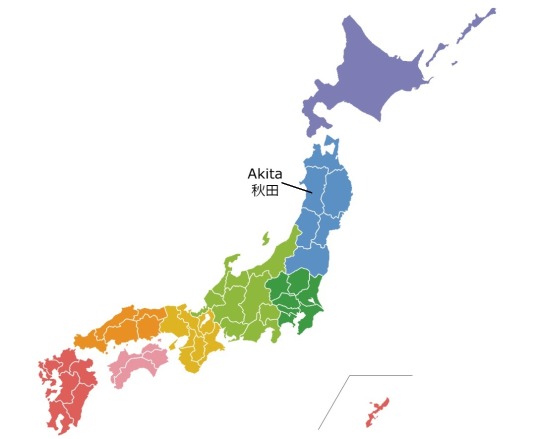
Akita prefecture is known for the natural beauty of the sea and mountains, hot springs, and the preserved samurai district in the town of Kakunodate. The capital of Akita prefecture is Akita City, and the economy of the prefecture is structured around traditional industries such as fishing and agriculture, particularly rice cultivation, as well as high-quality sake. Akita's numerous seasonal festivals offer insight into traditional culture, especially the New Year's Eve Namahage Festival of Oga, which is unique to the Oga Peninsula area of Akita prefecture. The Namahage are demon-like beings which are portrayed by men dressed as masked ogres (oni) with traditional straw capes (mino), who go door-to-door in pairs or threes and admonish children who are lazy or who have been behaving badly. They are commonly shown on TV news making children cry as they visit homes in the neighbourhood during the New Year celebrations. Other, less traumatizing, festivals include the Yokote Kamakura Festival in February, where igloo-like snow houses (kamakura) are built across the city of Yokote, inside of each of which is a snow altar to the water deity to pray for ample water; or the Tsuchizaki Shinmeisha Shrine Float Festival, where floats with warrior dolls parade around the port area of Akita City. The women of the region are also famous as 秋田美人 (Akita bijin) or "beauties of Akita" and are known for their white skin, rounded faces and high voices.
Recommended Tourist Spot・おすすめ観光スポット
Nyūtō Onsen - 乳頭温泉郷

By Bjckashiwa
Nyūtō Onsen is a traditional hot spring town in the eastern mountains of Akita. The town has six ryokan, or traditional inns, some of which date from the Edo period, and a hotel. The most famous hot springs is Tsurunoyu, which is over 300 years old, and considered to be one of the best establishments in all of Japan for a traditional and authentic onsen ryokan experience in the countryside. The onsen in the town can also be visited with general admission for those not staying in the inns. Most of the ryokan have mixed-gender onsen in addition to the male-only and female-only baths. The Yumeguri Pass can be purchased at the ryokan, allowing access to all seven of the hot springs, and a reservation at the ryokan on a shuttle bus allows for easy access to all of the onsen. Nyūtō Onsen means "nipple hot spring" referring to the shape of Mount Nyūtō nearby. The mountains and the deepest lake in Japan, Tazawako, are only a 30-minute bus ride from Nyūtō Onsen.
Regional Cuisine - 郷土料理
Kiritampo Hot Pot - きりたんぽ鍋

Photo from HIS
Kiritampo are tubes of rice mashed up into a paste, wrapped around a skewer, and grilled on an open flame. These traditional tubes of sticky rice are then placed in a nabe (hot pot) with local meats and vegetables and cooked together, creating a dish perfect for the frigid winter.
Akita Dialect・Akita-ben・秋田弁
泣く子はいねがぁ (naku ko wa ine gaa)
Standard Japanese: 泣く子はいないか (naku ko wa inai ka)
English: Is there a crybaby here?
Note: A standard line used by Namahage during the Namahage Festival
あい、しかだね (ai, shika dane)
Standard Japanese: ありゃ~、仕方ないなあ (arya, shikata nai naa)
English: Oh no, it can't be helped
Note: Said when the other person does something by accident (casual)
これをけ (kore o ke)
Standard Japanese: これを食べてください (kore o tabete kudasai)
English: Please eat this
どでした (do deshita)
Standard Japanese: びっくりした (bikkuri shita)
English: I was surprised
#japanese prefectures#日本語#japanese#japanese language#japanese langblr#langblr#studyblr#都道府県#秋田県#akita
100 notes
·
View notes
Text
Hello Japan
June 28, 2023.
Today was a travel day - but it was a short travel day, relatively speaking with a 2 hour flight to Japan - and just like that we were closer to home.

Japan is a LOT bigger than South Korea but Seoul with 25 million people is a lot bigger than Tokyo with 12 million. Both of those cities have more people than live in the entire state of Michigan since we have under 10 million. PHEW!!
Take a look at Japan transposed on Michigan. If you were to start in at the Mackinac Bridge and start driving you would be in Mexico before you got to the end of Japan territory. Surprised? So Japan is 51% bigger in land mass that Michigan but they has 144 MILLION more people that Michigan.

The first day we were here we just moved into our hotel in downtown Tokyo and had a lovely dinner to get to know our new guide, Ken-san. Tokyo feels different than Seoul and is not an vertical.

It is vertical - don't get me wrong - but there are more old "high rise" buildings of 10 - 15 stories and more old with the new. But this is really just a first impression.

Day 2 - June 29, 2023
Today we visited a Suma Wrestling facility. This is NOT a sport that I would EVER seek out - but now that I know more - I have to confess, I am kind of interested. - although NOT even close enough to attend an event. NO EVEN CLOSE!!! We spent an hour with Bungonishiki while he showed us some of his exercises.
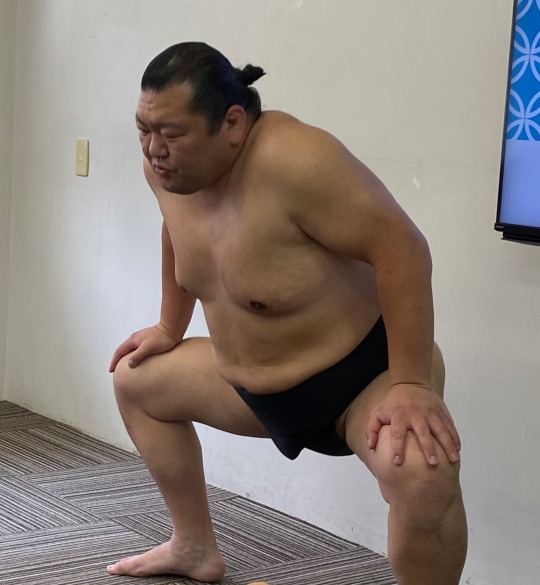
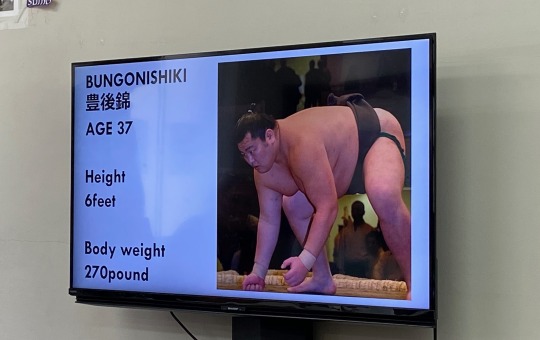
He is retired and now trying to keep the sport alive working with youth. He was willing to help us understand this ancient sport. He was a very nice man.
The average match is 7 second - FYI! The wrestlers live in a dorm like setting and eat an enormous amount of calories every day while training several hours.
The top 70 wrestlers earn an very good living and the top make a VERY good living - I'm talking FOUR million dollars a year.

We watched a couple of videos of matches including one with a guy who weighed 600 lbs and I am still trying to figure out how to "UNSEE" that. OMG!!! Later we went to see a Sumo ring. Before your match you fling a little salt to honor the gods. Who is the god of Sumo? you ask. No flipping idea.

This sport is old - it is kinda' like the jousting idiocy for Japan. Each kingdom or shogunate (this might not be the right word) had a bunch of the guys and they would challenge the group from another kingdom./shogunate. Now these guys have sponsors - like McDonalds - and I am not kidding. The grand champion (also not the right word) was sponsored by a Russian yogurt company. The skirt below (again - not the right word ) was the company that sponsored our friend.

On to lunch... We went to this delightful place where we had to remove our shoes - VERY COMMON PRACTICE - and then each of us had a little cast iron pot filled with broth, vegetable and chicken., called "nabe." or "hot pot." The flame will last long enough to cook everything in the pot. I thought the process was pretty cool and the food was delicious. Our little group of 11 were in two different rooms.


Next we took a walk and ended up in a pachinko parlor. I read the book "Pachinko" but I never actually understood what the parlor looked like nor how the game was played. But now I do.

The book was about WAY more than the Pachinko parlor however and we asked Ken-san about the current treatment of Korean heritage people living in Japan and he said it was much better now than before, I'm not sure what "before" covered but during "before" this people - no matter how many generations of their family had lived in Japan had no nationality. They were not permitted to have employment in high esteemed professions and had no voting or passport rights. A Pachinko parlor - because it is a gambling establishment - was considered "dirty" or "unworthy" (probably not the right word but you get the picture.). The Korean heritage people were permitted to work in Pachinko parlors. And although the gambling and the establishments are "dirty" they are used by everyone regardless of heritage.
We wanted to give it a try so Anson tried it and SURPRISE lost my money.

It may have had something to do with not having a clue what he was doing - but let's face it the house always wins.
From there we headed to a Bonsai shop. That entire process is remarkable!

My biggest surprise was to discover that these trees grow this way "in the wild" on different mountains. My second surprise was that these tiny and beautiful trees go through the entire season cycle. For example if you have a bonsai weeping cherry in the spring it will bloom, just like the one in my front yard. A flowering crabapple will bloom and produce teeny tiny apples.
Anyway one of the apprentices, who work 6 years, 7 days a week, 12 to 15 hours a day for room, board and training took us on a little tour of the place and showed us some of the techniques used by the gardeners to keep these trees looking beautiful.

The apprentice referred many times to “my Master” and it creeped me out. We got to meet his Master and he signed a book about Bonsai that Shannon and Jim purchased.
We discovered that these trees either flow left or right and owner needs to know that so that it can be placed correctly. If not - a person can ruin the feng shui of the entire home, business or organization. The tree below flows left.

It turns out that the gardener actually “freezes” (again - wrong word) the growth. An example is that tree that is 800 years old.

See the white wood. That is dead - but no more of the tree with die provided the caretaker knows what they are doing. Let in it natural habitat the tree would continue to di. These trees are beautiful and very, very pricey. Not to mention that you better have enough money to hire a gardener to take care of it. Check out the pic below - clearly they are flowing right. (I'm a quick study!)

We headed back to the hotel but before we knew it it was time to eat - AGAIN. This time we took a taxi.

Ken-san has told me that he feared this particular meal would be a little “wheat -heavy” so he had purchased a lovely salad for me while everyone else enjoyed the “gluten-FULL” meal. While it all looked good to me - I can say I did love the salad.


We opted for the subway on the way home and it was a delightful trip - with the exception that many of the stations are not very assessable. Mark and Jay are both using a cane and have become great buddies scoping out benches together. They are also both troopers but an escalator or an elevator would be nice. The subway stations and cars - like everything here - are immaculate.

We have a station right by our hotel - so super easy peasy. See...

Still loving Tokyo....
2 notes
·
View notes
Text
5 Famous Foods to Try in Kyoto
Traditional culinary culture has flourished in Kyoto, and you may get a taste of history with Japanese course meals prepared as part of a traditional tea ceremony and vegetarian cuisine influenced by Chinese Buddhism.
The town's local cuisine (Kyo-ryori) is colorful and visually appealing, thanks to the expertise of Japanese chefs. Everyone should have the opportunity to sample traditional Japanese cuisine in the stately setting of Kyoto at least once in their lives. Of course, fantastic food at reasonable costs is available.
We've compiled a list of some of the top local cuisines and budget-friendly treats that Kyoto residents enjoy daily.
Yudof (Boiled tofu):
Perhaps no food represents Kyoto more than you. It contains only tofu, water, kelp, and a dipping sauce. The kelp is put in the bottom of a stewpot, filled with tofu and water, and simmered. Tofu is scooped up and served with a dipping sauce, typically a ponzu soy sauce-based vinaigrette.
Hamo (Conger eel)
The spikey-toothed hamo (conger eel) is a difficult adversary to deal with. Small bones span the length of its slim body. Chefs make half-cuts into the filleted meat to make it tasty - 24 cuts within each three-centimeter span. Hamo can be boiled, grilled, deeply fried, and even used in shabu-shabu or nabe stew. Cold, boiled ham served with a tart ume (plum) sauce is especially popular in the summer.
Tsukemono (Japanese pickles)
Before the refrigerator, Japan kept its vegetables by pickling them in salt. When Kyoto was chosen as the nation's capital in 794, a slew of items from Japan began to arrive in Kyoto and at the imperial court. Local artisans attempted to refine these products, resulting in a varied range of Kyoto crafts, including tsukemono.
Kyoto's top tsukemono are three types of pickles: shibazuke, senmaizuke, and sugizuke. Shibazuke is a sour and crunchy pickled mixture of sliced cucumber and eggplant with scarlet shiso (perilla or beefsteak plant). Shiso turns the ingredients pink.
Matcha
Kyoto is a beautiful place to explore matcha because it is the birthplace of the tea ceremony. You may get frothy green tea at many tea shops on temple grounds or in popular tourist places, with or without the ceremony. In Japan, matcha is the most acceptable type of green tea. To improve its color, flavor, fragrance, and nutritional value, it is made from tea leaves cultivated under certain circumstances, dried, and ground in a similar environment. Everything here adds to the sensory experience of drinking matcha.
Matcha is also delightful in its various modern guises, like soft-serve ice cream, cake, biscuits, and crackers, which can be found around Kyoto.
Yatsuhashi
Yatsuhashi is the most famous Kyoto souvenir sweet. It's created of rice flour, sugar, and Nikki, a type of Japanese cinnamon. Warming the dough before shaping it into a thin, half-pipe form and baking it results in crisp, slightly challenging cookies that resemble little brown roof tiles. Since 1689, this type of yatsuhashi has been around.
Matcha and sesame tastes, as well as more recent additions like chocolate and banana, are available in addition to the traditional cinnamon flavor.
Do you want to find the best fish market in Tokyo? If so, Ninja Food Tours are for you. Our team members are natives who are motivated by the thriving culinary scene. Let us take you on a delectable journey filled with cuisine, laughter, and history. On Osaka food tours, you'll uncover Kyoto's hidden gems and sample authentic Japanese dishes you've probably never eaten. The tour price includes full-size meal samples as well as the guiding charge. The night trips also include two glasses of alcoholic beverages of your choosing.
#best food tours japan#food tour japan#best food in shinjuku#japan local tour guide#restaurants in kyoto#best restaurants in kyoto#ninja tokyo
10 notes
·
View notes